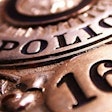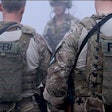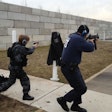This Memorial Day was an especially reflective one for me, with another tragic police death only three days before on May 25.
Last week Cleveland Heights, Ohio, police officer Jason West was first on the scene of a reported large disturbance. As he stepped from his cruiser, he was shot multiple times by a suspect with a handgun. Backup officers fired at the suspect who escaped on foot. Police report that they later arrested a man during the ensuing manhunt, hiding inside an occupied house that he allegedly had broken into. Officer West was rushed to the hospital, but he died from a fatal head wound.
As I reflect on this latest police tragedy, I am reminded of the April 23, 2005, shooting of Pittsburg, Calif, officer Larry Lasater who was killed as he approached on foot a bank robber's hidden position in heavy underbrush. A man was caught by other officers not far from the scene and charged with the shooting. Unfortunately, as with Officer West, brave efforts to save Officer Lasater fell short.
You're probably asking what these seemingly unrelated incidents have to do with each other, and where I'm going with this. The short answer is that both tragedies hit close to home for me. I grew up in Cleveland Heights, lived on the street where the shooting occurred, and spent my career in the adjacent Cleveland Police Department. When I retired, I moved to California and now live only a few miles from where Officer Lasater was shot. I drive past the location every week, and I think about it often.
But what really hits closest to home is that both officers were shot without warning by fleeing suspects who were determined to shoot the first police officer they saw. Tragically, neither of the above officers ever had a chance to shoot back or defend themselves. Officer West's gun was still holstered when he was shot, and Officer Lasater never fired his drawn gun.
Neither officer ever had a chance. They were ambushed by cowards who shot them before they could defend themselves. Those who track the shootings and murders of police officers know this is a scenario that is repeated all too often, and the common denominator is that the bad guys shot first. Despite police today being better trained, equipped, and armed than ever before, bad guys continue to shoot and kill far too many of us.
One major reason is that the bad guy's action is faster than our reaction. We prove this every day in training and on the street. Many criminals intuitively understand this and they "train" to take advantage of it. They know that we have to follow rules that say we must perceive a deadly threat before firing. The result is that bad guys will not hesitate to shoot first, as they did against officers West and Lasater.
Many attacks on police are a form of ambush, a proven effective deadly military tactic. The military trains extensively in ambush/counter-ambush tactics. Yet, despite having the best training, equipment, and tactics, our troops continue to suffer ambush casualties in Iraq and Afghanistan. That's how effective this tactic can be.
Police are also engaged in a war, albeit one that's far less intense, against bad guys who employ very similar tactics as those used by guerillas and insurgents. Hardcore bad guys have survival mindsets. They understand fight/flight, and they train to defeat police tactics. Consequently, we must always have strong officer survival attitudes, train realistically, constantly hone skills, and never let our guard down.
Although the above incidents did not involve SWAT, they had clear potential for turning into SWAT situations. SWAT has the advantage of enhanced training, tactics, teamwork, equipment, and weaponry. SWAT missions usually involve "known" danger, deploying multiple officers, with weapons at the ready.
In contrast, first responders usually deal with "unknown" danger, and cannot draw their weapons until/unless a threat manifests. All law enforcement agencies have strict rules governing drawing, displaying, pointing weapons. With the constant threats of civil, criminal, departmental action, the hope is that no officers will hesitate to defend themselves when they need to. This was not the case with the above two officers who never had a chance to defend themselves.
Surprise, shock, and speed are proven effective tactical principles. SWAT teams take advantage of action/reaction, buying precious time by first surprising then shocking their adversaries into a temporary inability to react and then overwhelming them with speed before they have time to recover. Many suspects also use these same principles against police.
Sudden attacks on police happen at lightning speed, and they can strike any of us at any time. Whatever you want to call it—action/reaction; ambush/counter-ambush; or surprise, shock, and speed—the results are the same: The aggressor has the advantage.
We need to develop effective countermeasures to protect officers from sudden, deadly attacks. It's time for all of us to put our collective "thinking caps" on to meet this daunting challenge. The lives we save in the future will be our reward.












